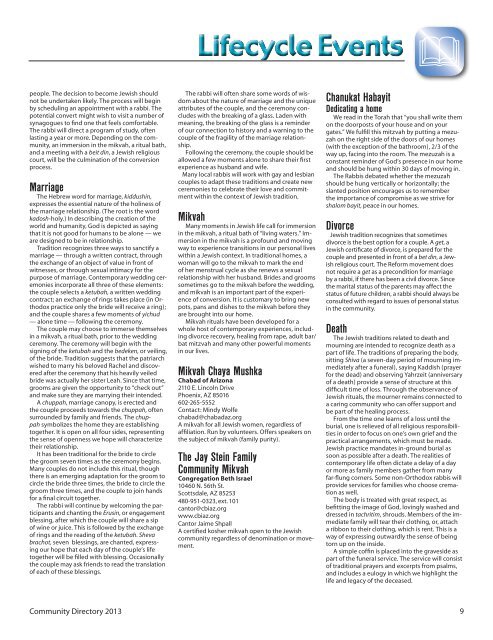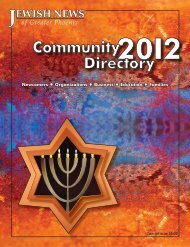downloadable PDF - Jewish News of Greater Phoenix
downloadable PDF - Jewish News of Greater Phoenix
downloadable PDF - Jewish News of Greater Phoenix
Create successful ePaper yourself
Turn your PDF publications into a flip-book with our unique Google optimized e-Paper software.
people. The decision to become <strong>Jewish</strong> should<br />
not be undertaken likely. The process will begin<br />
by scheduling an appointment with a rabbi. The<br />
potential convert might wish to visit a number <strong>of</strong><br />
synagogues to find one that feels comfortable.<br />
The rabbi will direct a program <strong>of</strong> study, <strong>of</strong>ten<br />
lasting a year or more. Depending on the community,<br />
an immersion in the mikvah, a ritual bath,<br />
and a meeting with a beit din, a <strong>Jewish</strong> religious<br />
court, will be the culmination <strong>of</strong> the conversion<br />
process.<br />
Marriage<br />
The Hebrew word for marriage, kiddushin,<br />
expresses the essential nature <strong>of</strong> the holiness <strong>of</strong><br />
the marriage relationship. (The root is the word<br />
kadosh-holy.) In describing the creation <strong>of</strong> the<br />
world and humanity, God is depicted as saying<br />
that it is not good for humans to be alone — we<br />
are designed to be in relationship.<br />
Tradition recognizes three ways to sanctify a<br />
marriage — through a written contract, through<br />
the exchange <strong>of</strong> an object <strong>of</strong> value in front <strong>of</strong><br />
witnesses, or through sexual intimacy for the<br />
purpose <strong>of</strong> marriage. Contemporary wedding ceremonies<br />
incorporate all three <strong>of</strong> these elements:<br />
the couple selects a ketubah, a written wedding<br />
contract; an exchange <strong>of</strong> rings takes place (in Orthodox<br />
practice only the bride will receive a ring);<br />
and the couple shares a few moments <strong>of</strong> yichud<br />
— alone time — following the ceremony.<br />
The couple may choose to immerse themselves<br />
in a mikvah, a ritual bath, prior to the wedding<br />
ceremony. The ceremony will begin with the<br />
signing <strong>of</strong> the ketubah and the bedeken, or veiling,<br />
<strong>of</strong> the bride. Tradition suggests that the patriarch<br />
wished to marry his beloved Rachel and discovered<br />
after the ceremony that his heavily veiled<br />
bride was actually her sister Leah. Since that time,<br />
grooms are given the opportunity to “check out”<br />
and make sure they are marrying their intended.<br />
A chuppah, marriage canopy, is erected and<br />
the couple proceeds towards the chuppah, <strong>of</strong>ten<br />
surrounded by family and friends. The chuppah<br />
symbolizes the home they are establishing<br />
together. It is open on all four sides, representing<br />
the sense <strong>of</strong> openness we hope will characterize<br />
their relationship.<br />
It has been traditional for the bride to circle<br />
the groom seven times as the ceremony begins.<br />
Many couples do not include this ritual, though<br />
there is an emerging adaptation for the groom to<br />
circle the bride three times, the bride to circle the<br />
groom three times, and the couple to join hands<br />
for a final circuit together.<br />
The rabbi will continue by welcoming the participants<br />
and chanting the Erusin, or engagement<br />
blessing, after which the couple will share a sip<br />
<strong>of</strong> wine or juice. This is followed by the exchange<br />
<strong>of</strong> rings and the reading <strong>of</strong> the ketubah. Sheva<br />
brachot, seven blessings, are chanted, expressing<br />
our hope that each day <strong>of</strong> the couple’s life<br />
together will be filled with blessing. Occasionally<br />
the couple may ask friends to read the translation<br />
<strong>of</strong> each <strong>of</strong> these blessings.<br />
Lifecycle Events<br />
The rabbi will <strong>of</strong>ten share some words <strong>of</strong> wisdom<br />
about the nature <strong>of</strong> marriage and the unique<br />
attributes <strong>of</strong> the couple, and the ceremony concludes<br />
with the breaking <strong>of</strong> a glass. Laden with<br />
meaning, the breaking <strong>of</strong> the glass is a reminder<br />
<strong>of</strong> our connection to history and a warning to the<br />
couple <strong>of</strong> the fragility <strong>of</strong> the marriage relationship.<br />
Following the ceremony, the couple should be<br />
allowed a few moments alone to share their first<br />
experience as husband and wife.<br />
Many local rabbis will work with gay and lesbian<br />
couples to adapt these traditions and create new<br />
ceremonies to celebrate their love and commitment<br />
within the context <strong>of</strong> <strong>Jewish</strong> tradition.<br />
Mikvah<br />
Many moments in <strong>Jewish</strong> life call for immersion<br />
in the mikvah, a ritual bath <strong>of</strong> “living waters.” Immersion<br />
in the mikvah is a pr<strong>of</strong>ound and moving<br />
way to experience transitions in our personal lives<br />
within a <strong>Jewish</strong> context. In traditional homes, a<br />
woman will go to the mikvah to mark the end<br />
<strong>of</strong> her menstrual cycle as she renews a sexual<br />
relationship with her husband. Brides and grooms<br />
sometimes go to the mikvah before the wedding,<br />
and mikvah is an important part <strong>of</strong> the experience<br />
<strong>of</strong> conversion. It is customary to bring new<br />
pots, pans and dishes to the mikvah before they<br />
are brought into our home.<br />
Mikvah rituals have been developed for a<br />
whole host <strong>of</strong> contemporary experiences, including<br />
divorce recovery, healing from rape, adult bar/<br />
bat mitzvah and many other powerful moments<br />
in our lives.<br />
Mikvah Chaya Mushka<br />
Chabad <strong>of</strong> Arizona<br />
2110 E. Lincoln Drive<br />
<strong>Phoenix</strong>, AZ 85016<br />
602-265-5552<br />
Contact: Mindy Wolfe<br />
chabad@chabadaz.org<br />
A mikvah for all <strong>Jewish</strong> women, regardless <strong>of</strong><br />
affiliation. Run by volunteers. Offers speakers on<br />
the subject <strong>of</strong> mikvah (family purity).<br />
The Jay Stein Family<br />
Community Mikvah<br />
Congregation Beth Israel<br />
10460 N. 56th St.<br />
Scottsdale, AZ 85253<br />
480-951-0323, ext. 101<br />
cantor@cbiaz.org<br />
www.cbiaz.org<br />
Cantor Jaime Shpall<br />
A certified kosher mikvah open to the <strong>Jewish</strong><br />
community regardless <strong>of</strong> denomination or movement.<br />
�<br />
Chanukat Habayit<br />
Dedicating a home<br />
We read in the Torah that “you shall write them<br />
on the doorposts <strong>of</strong> your house and on your<br />
gates.” We fulfill this mitzvah by putting a mezuzah<br />
on the right side <strong>of</strong> the doors <strong>of</strong> our homes<br />
(with the exception <strong>of</strong> the bathroom), 2/3 <strong>of</strong> the<br />
way up, facing into the room. The mezuzah is a<br />
constant reminder <strong>of</strong> God’s presence in our home<br />
and should be hung within 30 days <strong>of</strong> moving in.<br />
The Rabbis debated whether the mezuzah<br />
should be hung vertically or horizontally; the<br />
slanted position encourages us to remember<br />
the importance <strong>of</strong> compromise as we strive for<br />
shalom bayit, peace in our homes.<br />
Divorce<br />
<strong>Jewish</strong> tradition recognizes that sometimes<br />
divorce is the best option for a couple. A get, a<br />
<strong>Jewish</strong> certificate <strong>of</strong> divorce, is prepared for the<br />
couple and presented in front <strong>of</strong> a bet din, a <strong>Jewish</strong><br />
religious court. The Reform movement does<br />
not require a get as a precondition for marriage<br />
by a rabbi, if there has been a civil divorce. Since<br />
the marital status <strong>of</strong> the parents may affect the<br />
status <strong>of</strong> future children, a rabbi should always be<br />
consulted with regard to issues <strong>of</strong> personal status<br />
in the community.<br />
Death<br />
The <strong>Jewish</strong> traditions related to death and<br />
mourning are intended to recognize death as a<br />
part <strong>of</strong> life. The traditions <strong>of</strong> preparing the body,<br />
sitting Shiva (a seven-day period <strong>of</strong> mourning immediately<br />
after a funeral), saying Kaddish (prayer<br />
for the dead) and observing Yahrzeit (anniversary<br />
<strong>of</strong> a death) provide a sense <strong>of</strong> structure at this<br />
difficult time <strong>of</strong> loss. Through the observance <strong>of</strong><br />
<strong>Jewish</strong> rituals, the mourner remains connected to<br />
a caring community who can <strong>of</strong>fer support and<br />
be part <strong>of</strong> the healing process.<br />
From the time one learns <strong>of</strong> a loss until the<br />
burial, one is relieved <strong>of</strong> all religious responsibilities<br />
in order to focus on one’s own grief and the<br />
practical arrangements, which must be made.<br />
<strong>Jewish</strong> practice mandates in-ground burial as<br />
soon as possible after a death. The realities <strong>of</strong><br />
contemporary life <strong>of</strong>ten dictate a delay <strong>of</strong> a day<br />
or more as family members gather from many<br />
far-flung corners. Some non-Orthodox rabbis will<br />
provide services for families who choose cremation<br />
as well.<br />
The body is treated with great respect, as<br />
befitting the image <strong>of</strong> God, lovingly washed and<br />
dressed in tachritim, shrouds. Members <strong>of</strong> the immediate<br />
family will tear their clothing, or, attach<br />
a ribbon to their clothing, which is rent. This is a<br />
way <strong>of</strong> expressing outwardly the sense <strong>of</strong> being<br />
torn up on the inside.<br />
A simple c<strong>of</strong>fin is placed into the graveside as<br />
part <strong>of</strong> the funeral service. The service will consist<br />
<strong>of</strong> traditional prayers and excerpts from psalms,<br />
and includes a eulogy in which we highlight the<br />
life and legacy <strong>of</strong> the deceased.<br />
Community Directory 2013 9



